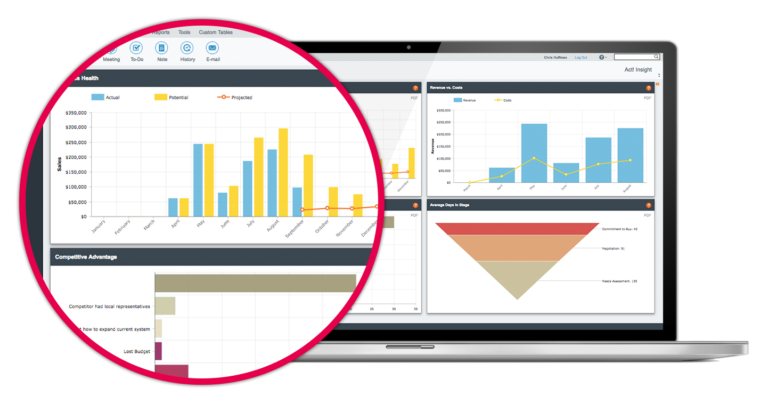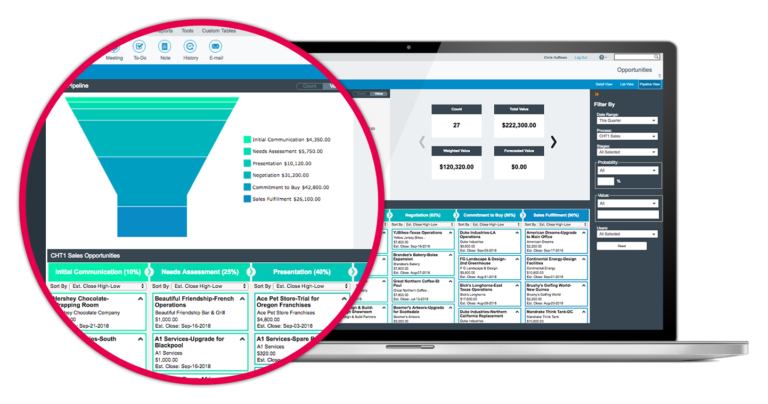JavaScript is required for our website to function.
Please disable any browser extensions that block JavaScript from loading.
JavaScript is required for our website to function.
Please disable any browser extensions that block JavaScript from loading.
There would be nothing better than the ability to gaze into a crystal ball and be able to see the future of our business. Unfortunately, the world doesn’t quite work that way – especially when it comes to sales. But a sales forecast can, at the very least, give us a glimpse into the future.
What is sales forecasting?
Why is sales forecasting important?
What do you need to create a sales forecast?
How to forecast sales?
Sales forecasting example
Sales forecasting is a process in which a company can estimate their future sales based on previous data and industry comparisons. As a process, sales forecasting allows companies to utilise this data in order to produce accurate performance plans which can shape the way they do business.
Some of the key areas which a sales forecast can benefit your business are predicting sales revenues for varied lengths of time which allows the business to appropriately assign resources where needed and to develop data driven plans for future growth and expansion.
Throughout this article we will cover how to forecast sales as well as sales forecasting methods and sales forecasting examples, all so that you can fuel business growth.
With our sales forecast definition handled, we will next cover the importance of sales forecasts for your business. Sales forecasts, put simply, can define many of the decisions your company makes in several ways and provides the necessary data to do so.
One of the most important aspects of any sales team is their targets. Sales targets are the standards each employee or department must reach in order to achieve the company’s goals.
Sales forecasting allows a company to set targets with incredible accuracy. With accurate and achievable targets set throughout all areas of the company, your sales teams can work more efficiently towards your overall success.
Alongside improving your ability to set targets, sales forecasting can influence business decisions ranging from budgeting to recruitment of new employees. By predicting the amount of expected sales and the associated revenue, you may see fit to hire new employees to meet the opportunities available.
In regards to sales forecasting methods, it is incredibly important to first start with the requirements for creating a sales forecast. Below we have a list of everything that you should have considered or documented before creating your sales forecast.
As well as automating this process and making it more efficient, a sales forecasting CRM will produce insight reports into the performance of your sales, allow you to allocate your resources towards higher possibility sales and view conversion rates for your sales funnel.
Information regarding your sales process should include all elements of your sales funnel such as; time taken for a customer to express interest, time taken to close a sale, the average cost of your product or service, typical retention rates and so on.
Your company sales goals: Alongside your company’s sale process, the goals and quotas which your company seeks to achieve are important information to feed the sales forecast CRM. Your goals act as a benchmark from where you can analyse the usefulness of the sales forecast. In order for this process to provide maximum efficiency, sales targets and goals should be allocated to individual employees and departments as well as the company as a whole, if you did not already have this information.

With everything necessary for sales forecasting on the table, you are now ready to work through the various sales forecasting methods and choose the one which will bring the most benefit to your company. Each method has benefits depending on the way your company runs and it can be prudent to use two or more methods in order to achieve the results you are looking for.
The drawback of using historical data is it fails to incorporate any features of the company that may have changed since the original data was collected such as your competitors growing or shrinking, whether you hired new employees or any differences in your offerings. Utilising historical data is one of the sales forecasting methods which we suggest using alongside another.
Industry sales forecast: Industry sales forecast is an ideal method to pair with using historical data as it assumes you have done so already. The method, put simply, applies your historical data to a sales forecast of your industry to provide an analysis of where you will fall within. The data for this can be obtained from the government, trade associations or other outside agencies which makes it an inexpensive and quick method.
Survey of buyers’ intentions: A survey of buyers’ intentions begins with creating a list of any and all potential buyers and conducting face to face interviews with a selected group of them. This method enables you to better understand their intentions and create an estimation of sales for all your buyers via sampling. It is important to note that a survey of buyers’ intentions is primarily used in industrial markets, however it can be useful across the board.
Using deal stages: With using deal stages as one of our sales forecasting methods, you assess the likelihood of being able to close a deal during each stage of your sales process or funnel. From this, you can multiply the likelihood of a sale against the size of the sale in order to give estimated earnings from the deal.

With sales forecasting methods squared away, it is time to look at what a sales forecasting example looks like and to assess the ways in which it can benefit your company. Some of the examples will stem from the earlier methods we laid out for you.
If your company has three deals in the pipeline like so:
Your research shows that each stage has the following chances of closing:
You can now use the likelihood of closing and multiply against the assumed value of the sale. The resulting amounts can be added together to give a representation of the value of your current pipeline along with a sales forecast for the future.
If during January the previous year your company gained £100,000 in new business and year over year, typically grows at a rate of 15%, it can be assumed that this year in January your company will generate £115,000 in revenue for new business.
This example is incredibly simple and therein lies its benefit.
A multi-variable analysis is one of the more complex sales forecasting methods in that it incorporates information from various parts of the company.
Imagine two sales employees that are working on a single account and the first employee has a meeting scheduled for Friday regarding the procurement and your second employee just finished a presentation to the buying committee.
First take the first employee’s success rate for this stage of your sales process and multiply that against the predicted size of the sale. For example, 40% likelihood of the first employee closing gives a forecast of £9,600.
Secondly, your second employee is earlier in the sales funnel but has a higher close rate and is working on a smaller deal. They are 40% likely to close which gives a forecast of £6,800.
By adding those two amounts together you have a sales forecast of £16,400 for that period.
This sales forecasting example relies heavily on very accurate data on your employees and their sales closing rates, the estimated size of your sales and such.
Need help creating your sales forecast? Download our free template by clicking on the button below.
Act! is a powerful sales and marketing automation platform designed to provide businesses with everything they need to run and grow their business. Here are some of the features that will benefit sales teams: